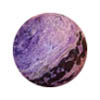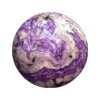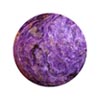- sale
- new items
- lovely beads
- wedding beads
- beads for teens
- for custom order
- newsletter
- recognition
- testimonials
- birthstones
- zodiac signs
- jewelry guide
SHOP BAG
![]() in your bag 0 items
in your bag 0 items
|
Charoite is a very rare translucent mineral of intense lavender to purple color. It has an unusual swirling, fibrous appearance, sometimes chatoyant, and pearly luster. The only deposit of charoite in the world is located in Siberia, in Russia, on the border of Sakha Republic (Yakutsk region) and Irkutsk region, in the Chara River valley. This area was completely uninhabited and very difficult of access because of rocks, mountains and wild Siberian forests. The boulders with inclusions of unknown violet mineral were found in 1948 by the Soviet geologist V.G.Ditmar, he called them conditionally "kumganit slanets". The first deposit of charoite was discovered in 1960 by the Soviet geologists Yuriy Gavrilovich Rogov and his wife V.P.Rogova. In the early 1970's, thorough research of this area and it's mineral deposits (including charoite) started because of the Baikal-Amur railroad project. In 1977 charoite was officially recognized as a new mineral. The charoite deposit covers about 20 square kilometers, and the age of rocks is about 125 to 145 million years old. The limit of charoite mining is set at 100,000 kilograms a year by the Ministry of Natural Resources of the Russian Federation and by the Sakha Republic law. 1 kilogram of rough charoite costs $30-150, depending on the mineral color, inclusions and so on. English Wikipedia states: "Russia has fairly strict prohibitions on the exportation of charoite. Generally, charoite is permitted to be exported only after the stone has been worked, for example, into figurines or other type ornaments. It is therefore difficult to procure "unworked" or "rough" charoite in a form suitable for further working into jewelry such as cabochons." Tales, legends and stories on charoite 1. Russian Wikipedia says nothing about the name "charoite", but it does indeed come from the Chara river. English Wikipedia says, that the mineral is named for the Chara River, though this etymology is disputed by some. 2. Here ( http://www.webmineral.com/data/Charoite.shtml ) it is said: "the mineral charoite is named for the impression that it gives: "chary" in Russian means "charms" or "magic" and not for the Chara River, which is 70 km away from the locality". Most likely, that is the legend, at that times new minerals, metals and so on were usually being named after persons or geographical names. 3. The discoverer of charoite, Y.G.Rogov, was in Paris on business and stopped by the Louvre Museum of Mineralogy. They were proud to have what they thought to be a complete collection of all the minerals of the Earth. Rogov showed their experts a piece of charoite, and asked them to identify the mineral. They had to admit that they didn't know what this unusual gem was. They asked to buy the sample, but Rogov refused to sell it to them. |




